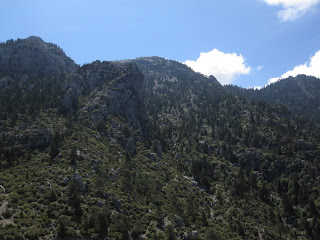I have spent the last couple days in a medium-sized town in northern Morocco called Chefchaouen or Chaouen for short. It is a beautiful place in the foothills of the Rif mountains. Here is a link to some nice photos of the town.
Part of what makes the town so beautiful to me is the fact that much of it is blue. Literally. Check it out.
And there are all of these wonderful doors. Here is a nice example.
A quick google search will reveal that marijuana is a big deal in this part of Morocco. A lot of it is grown in the Rif, and in certain parts of Chefchaouen young men are ever trying to sell hash to the tourists. But I have found that it is fairly easy to avoid. And the charms of the city far outweigh this minor hassle.
For me Chefchaouen strikes a nice balance. It certainly is touristy, and there are lots of us here. But walk a few blocks from the main square in the medina or better yet, leave the medina for the ciudad nueva--Spanish influence here, along with French--and it is very easy to find yourself surrounded by locals just doing their thing.
Speaking of taking respite from tourist overload, today I went for a nice hike up out of town into the Rif. There was an interesting mix of people up in the mountains. There were a few locals, herding goats, tending crops, etc. There was a group of 30 or so bankers up from Casablanca for the weekend. I spoke with a couple of them for a bit. They were very friendly, offering me dried fruit and nuts, talking about everything from Crater Lake--one of them lived in California--to international free trade. The only other foreign tourists I saw was a French couple.
The Rif remind me a tiny bit of Oregon's Siskiyous or Elkhorns. Rocky in a kind of understated way.
And apparently spring is a good time to visit. It was a riot of wildflowers up there!
It has been really nice to be able to just chill out in a beautiful little town surrounded by mountains for a couple days, eat good food, get lost in the beautiful, blue medina, go for a challenging hike. All the while, I've been spending time meditating on Islam... more on this later.
But tomorrow I will take a bus to Fez. I'll be there just a couple nights, and then I'll begin my journey home: Casablanca for a night, Geneva for a night, Cincinnati... And honestly, I am a little intimidated by the thought of Fez. It sounds like rather an intense place to visit. But for some reason I'm drawn there. We'll see. Wish me luck!










